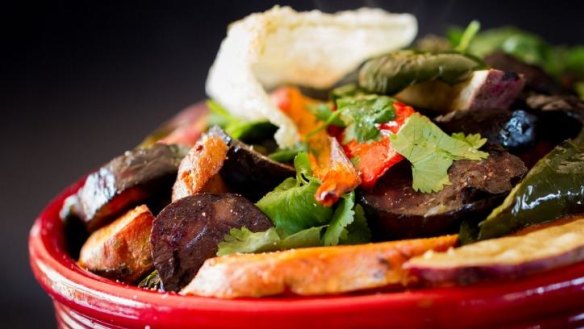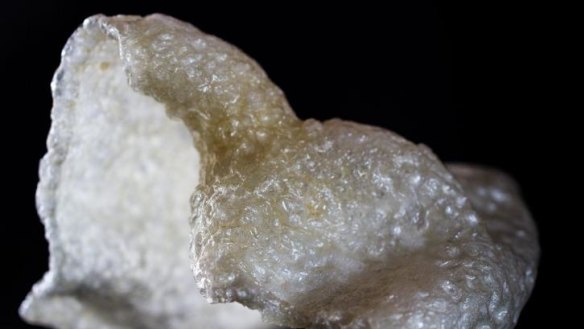Bryan Martin's Peruvian breakfast with chicharron and lime

Breakfast, if you believe all the anecdotal information bandied around, mostly by cereal companies, is the most important meal of the day. You could question this. If this is so essential, why is it the meal we spend so little time planning and making? Just pouring sugary cereal into a bowl and covering it with cow's milk seems such a waste of time and effort.
I suspect that this is all a hangover from when we used to have to hunt for food and avoid being eaten by large cats or worked long days in coal mines. I'm pretty sure that it's importance is kind of diminished somewhat when all you do is jump into a car, drive to work and then sit in front of a computer screen for the rest of the morning before thinking about lunch.
This is obviously coming from someone who hasn't ever really embraced eating as soon as I wake. I wish I could some days, especially if there's fresh bread and farm eggs but alas, as hard as I try, I can't face eating then - it's way later in the day that food gets my attention.

Recently, my niece visited an exotic friend from out-the-way Perth, as my niece likes to call our western capital. I can't say that you should be surprised to feel isolated when you move to the other side of the country and into the cauldron that is Perth. Her friend is from Peru and is coming for brunch. This gives me an opportunity to research a different food culture, which I love doing. For example, did you know there is such a thing as an Inuit diet? I'm sure the Inuit people eat stuff but a "diet" to lose weight or stay healthy based solely on protein and seal fat would seem a tad desperate.
Turns out Peruvians do have a fairly robust breakfast as you would if the first thing you have to do each day is climb a mountain range to get anywhere or look for your lost alpacas. Yes, I know I have a lot of gaps in my knowledge of Peruvian culture. I rejoice in the journey.
There's a lot going on in this dish and can take some time to gather the ingredients, but I managed to find all this in a day.
Chorizo, a cured spicy pork sausage is used in various forms in most Spanish and Portuguese-speaking countries and does deftly give the dish an easy authenticity. Morcilla sausage is a little harder to find but it'sout there and almost dissolves into the sauce to add a delicious richness. I found these poblano peppers quite fortuitously at Coles of all places. These peppers are a dark green colour, have a varied heat from sweet to pretty hot and they roast so well.
For me, they made the dish and made me look like I'd spent way more time planning than I did. The chicharron, crispy pig skin, is probably going to stump you a bit, it's a by-product of using the pork belly in the dish. It's a long process to cook, scrape and dehydrate the pig skin but it will impress Peruvian guests no end. You could leave it out and serve with tamales or tortillas.
A light Peruvian breakfast or brunch served with chicharron and lime
1kg pork belly
2 tbsp sugar
1 tbsp salt
1 dried passila chilli (see note below)
1 red onion, chopped
2 cloves garlic, chopped
2 limes
6 poblano peppers (see note below)
2 rocoto peppers (see note below)
olive oil
6 chorizo sausages, sliced thickly
1 morcilla sausage (blood sausage) sliced
1 tsp smoked paprika
6 tomatoes, roughly chopped
1 bunch coriander, chopped
salt, pepper
Start the day before by removing the pork skin in one piece: have your butcher do this if you can. Boil the pig skin for two hours until very soft, drain and chill weighted down so that it is flat. Once cold, scrape off as much fat as you can and cut into 3-centimetre squares. In a food dehydrator or oven, set the temperature to about 60C and dry for six to eight hours until they are see-through, rock hard and glassy. Set aside until needed
Mix together two tablespoons of sugar with one of salt and rub the pork belly with this. Cure for four hours, rinse off and bake in a moderate oven, 130C, for two hours until cooked through. Cool at room temperature and chill in the fridge. Slice into thick rashers for use.
Soak the chilli in warm water for few hours and chop with onion and garlic. Finely grate the zest of the limes into a bowl and then add the juice. Set both aside. Cut the peppers in half, brush with olive oil and bake in a hot oven until charred and soft.
Heat a large frypan, add a splash of oil and saute each of the meats separately, just to give them a little colour, careful with blood sausage, they burn easily. Keep warm.
Clean the pan, and in fresh oil, fry the chopped onion, garlic and chilli for a few minutes and sprinkled with paprika and add the tomatoes. Cook this for 10 minutes and add the meats and cooked peppers. Cover and bake in a moderate oven for 15 minutes.
Meanwhile, heat a deep fryer to 180C and deep fry the prepared pork skin until it puffs up dramatically. Season with salt and pepper.
Serve the stew piping hot with chicharron, lime juice and coriander on the side.
Note: Chilli, peppers and capsicum. You can just use a mixture of red, yellow and green bullhorn peppers or capsicum. Do your best and try the markets. Pasilla chillies were Herbies brand, available from Delis, Essential ingredient and Cooking Coordinates.
Bryan Martin is the winemaker at Clonakilla and Ravensworth
Restaurant reviews, news and the hottest openings served to your inbox.
Sign up